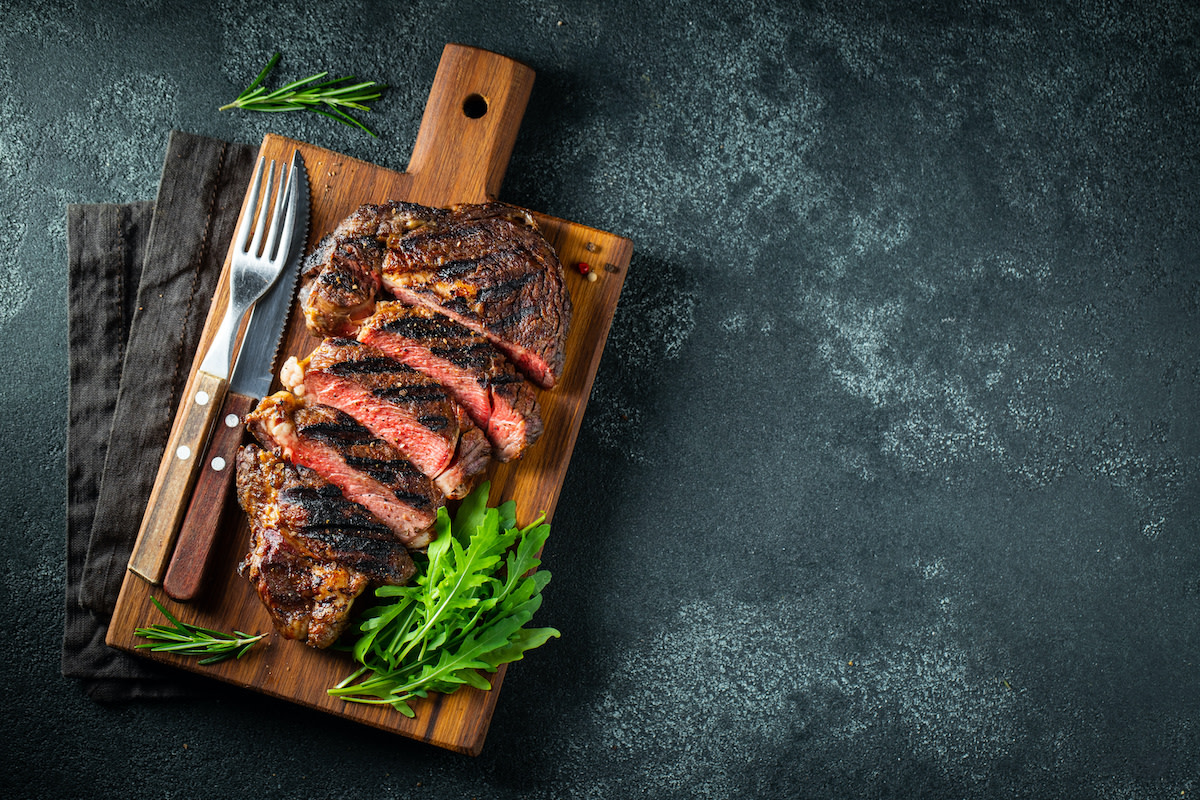Filet Mignon vs. Ribeye Steak: What’s the Difference?
Written by MasterClass
Last updated: Dec 14, 2021 • 4 min read
Filet mignon and ribeye are two of the most popular types of steak cuts. There are some subtle differences between filet mignon and ribeye when it comes to taste, texture, and tenderness.
Learn From the Best
What Is Filet Mignon?
Filet mignon is a cut of steak that comes from the tenderloin of the cow's loin primal. The tenderloin muscle is a part of a cow that bears no weight and is mostly unused, which prevents the connective tissue from becoming tough. The filet mignon is tender with a mild yet distinctive flavor. You may serve filet mignon in its own juices or with butter or sauce to bring out the mild flavor. Some chefs and home cooks prepare the filets with seasoning rubs or wrap them in bacon prior to cooking.
The name ”filet mignon” is French, which translates into “dainty thick slice,” as portions are between one and two inches thick and one and three inches in diameter. The cuts are naturally round since they're taken from the tube-shaped ends of the tenderloin muscles, and they're generally trimmed of all fat to ensure optimal tenderness. The cut is smaller than other cuts such as T-bone and ribeye steaks.
How to Cook Filet Mignon
Chefs and home cooks prepare filet mignon in a variety of ways. The most common cooking method combines searing and baking in the oven. Other methods include grilling, roasting, frying, baking, and broiling. To cook filet mignon with the sear-and-bake method, follow these instructions:
- Allow the raw steak to reach room temperature. Remove the filet mignon steaks from the refrigerator and set them on the counter for up to thirty minutes. This allows the meat to reach room temperature, which helps ensure even cooking. Preheat your oven to 350 degrees Fahrenheit.
- Sear the steak. Heat a teaspoon of oil in a cast-iron skillet. When the oil is ready, place the steaks in the skillet. Sear the steaks for approximately three minutes on each side, or until the meat develops a crispy brown crust.
- Bake the steak. Keep the seared steaks in the skillet and move the skillet into the oven. Bake the steaks for approximately six to eight minutes or until the meat reaches your desired temperature. Filet mignon steaks are commonly served medium-rare, but it's not a hard-and-fast rule.
- Let the steak rest before serving. Allow the filet mignon steaks to sit for approximately eight minutes prior to slicing and serving.
What Is Ribeye Steak?
Ribeye is a tender cut of steak known for its full-bodied, savory flavor and high fat content. Ribeyes come from the part of the cow referred to as the primal beef rib, which is the same area that prime rib comes from. The location of the meat tends to collect additional intramuscular fat, which results in unique marbling. As a ribeye cooks, the white fat marbling melts into the meat to create a juicy and tender texture.
Ribeye steaks come as both boneless or bone-in, with boneless cuts being easier to prepare. Bone-in ribeye steaks are insulated by the bone and retain moisture when cooking. This type of ribeye is slightly more difficult to cook, but some steak connoisseurs are willing to put in the extra work to enjoy the benefits of extra juiciness.
How to Cook Ribeye Steak
Ribeye steaks are most often cooked medium-rare, and a common way to prepare a ribeye is in a skillet. To utilize this method, follow these instructions:
- Allow the steak to reach room temperature. Remove the ribeye steak from the refrigerator and season both sides with salt and pepper. Let the steak sit for approximately thirty minutes or until it reaches room temperature.
- Sear the steak. Sear the cut of meat in a dry skillet for approximately four minutes. Flip the steak over and sear on the opposite side for approximately three minutes.
- Let the steak rest. Allow the steak to sit for approximately two minutes prior to serving.
If you're planning to serve more than two steaks, consider using a grill. Ribeye steaks can be prepared with range-top grills and outdoor grills.
Filet Mignon vs. Ribeye: What’s the Difference?
There are a few key differences when comparing filet mignon and ribeye, with the part of the cow in which the cuts come from being one of the main distinctions.
- Cut of meat: Ribeye comes from the section of a cow's rib cage that covers ribs six through twelve, while filet mignon comes from the tenderloin.
- Texture: Filet mignon and ribeye steaks are two of the most popular cuts of beef, both known for their tender texture. However, filet mignon tends to be more tender than ribeye because the muscular section in which the meat is located is unused by the live animal, which helps prevent toughness due to physical exertion.
- Flavor: Filet mignon is known for its mild flavor as it lacks fat, while ribeye steaks contain more marbling to contribute to a rich, beefy taste. Serve filet mignon steaks with rich sauces or butter to enhance the overall flavor. Ribeye steaks generally only require a small amount of salt and pepper to allow the flavor to fully come out.
Want to Learn More About Cooking?
Become a better chef with the MasterClass Annual Membership. Gain access to exclusive video lessons taught by the world’s best, including Gordon Ramsay, Gabriela Cámara, Chef Thomas Keller, Dominique Ansel, Yotam Ottolenghi, Alice Waters, and more.
